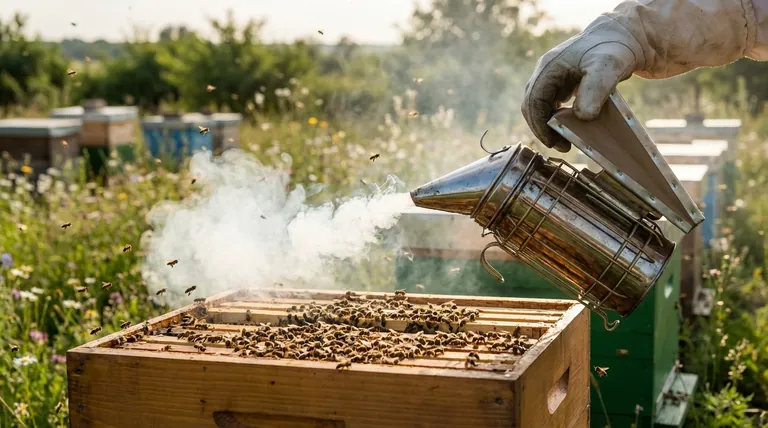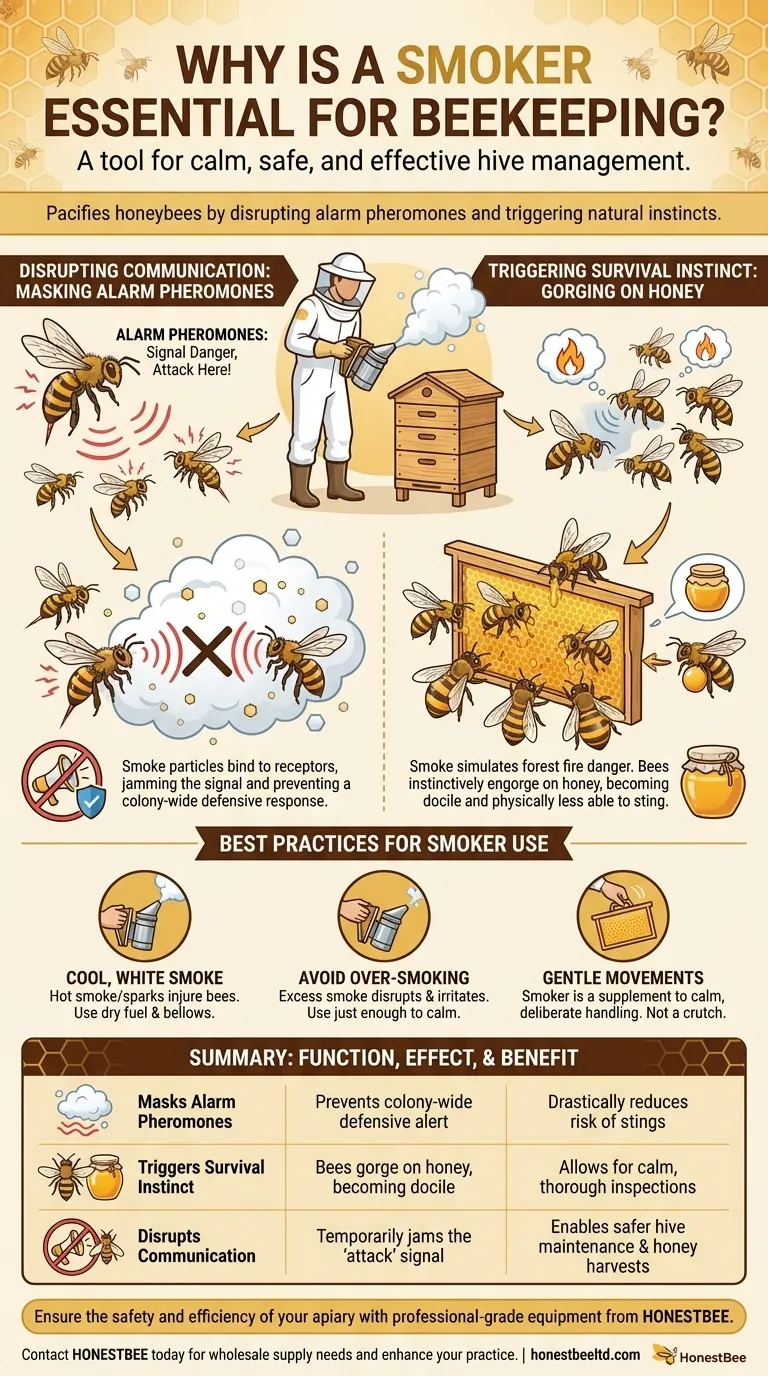At its core, a bee smoker is an essential tool for hive management because it pacifies honeybees, making inspections safer and less stressful for both the beekeeper and the colony. It works by disrupting the bees' primary method of communication—alarm pheromones—and triggering a natural survival instinct that makes them more docile. This allows a beekeeper to open and work within a hive without provoking a mass defensive response.
The smoker is not a tool of force; it is a tool of communication disruption. By temporarily disabling the bees' ability to raise a colony-wide alarm, you can perform necessary maintenance without being perceived as a catastrophic threat.

How Smoke Fundamentally Alters Bee Behavior
To understand the smoker's importance, you must understand how it interacts with the honeybee's sophisticated defensive instincts. It leverages two key behavioral responses.
Disrupting the "Alarm System"
When a guard bee perceives a threat or is injured, it releases alarm pheromones. This chemical signal instantly alerts nearby bees, broadcasting a message of "danger, attack here!"
This can trigger a chain reaction, quickly escalating a minor disturbance into a full-scale defensive assault where hundreds or thousands of bees become agitated and ready to sting.
Cool, white smoke from the smoker effectively masks these pheromones. The particles in the smoke bind to the bees' antennae receptors, essentially jamming the signal and preventing the alarm from spreading throughout the colony.
Triggering a Survival Instinct
The presence of smoke also triggers a much deeper, more ancient survival response related to forest fires.
When bees sense smoke, their instinct tells them the hive may be in danger and they might need to abandon it. In preparation, they begin to gorge on honey, loading up on energy reserves for a potential journey to a new home.
A bee with a full abdomen of honey is physically less able to flex its body to sting. This act of engorging also has a significant calming effect, making the bees preoccupied and far more docile.
Understanding the Trade-offs and Best Practices
While a smoker is invaluable, its effectiveness depends entirely on proper use. Misuse can be counterproductive or even harmful.
The Importance of "Cool" Smoke
The goal is to produce thick, cool, white smoke. Hot smoke or sparks from the smoker can injure or kill bees, which will rightfully agitate the colony and release more alarm pheromones, defeating the purpose.
Always use appropriate, dry fuel (like pine needles, burlap, or cotton) and ensure you are puffing bellows to create smoke, not projecting a flame.
The Risk of Over-Smoking
A little smoke goes a long way. Using too much smoke can be overly disruptive, causing bees to flee frames and making your inspection more difficult.
Excessive smoke can also irritate the bees and, in extreme cases, may taint the flavor of uncapped honey. The principle is to use just enough to keep the bees calm, not to flood the hive.
It's a Tool, Not a Crutch
A smoker is a supplement to, not a replacement for, calm and gentle beekeeping practices. Smooth, deliberate movements are just as important for keeping a hive calm.
Relying solely on smoke while handling frames roughly or crushing bees will still result in a defensive colony. The best results come from combining good technique with judicious use of the smoker.
Applying the Smoker for a Calm Hive Inspection
Your approach should adapt to the goal of your inspection.
- If your primary focus is a quick, routine check: A few gentle puffs at the hive entrance and under the outer cover are often sufficient to set a calm tone before you begin.
- If your primary focus is a deep inspection or honey harvest: Use the smoker methodically, applying a light puff of smoke across the top of the frames as you remove the inner cover and between frames as you work your way through the hive.
- If you encounter sudden aggression: A few extra, directed puffs can quickly de-escalate the situation by breaking the pheromone chain reaction that has already begun.
Ultimately, mastering the smoker is about learning to manage your hive's collective mood, ensuring every inspection is a peaceful and productive event.
Summary Table:
| Key Function | Effect on Bees | Benefit for Beekeeper |
|---|---|---|
| Masks Alarm Pheromones | Prevents colony-wide defensive alert | Drastically reduces risk of stings |
| Triggers Survival Instinct | Bees gorge on honey, becoming docile | Allows for calm, thorough inspections |
| Disrupts Communication | Temporarily jams the 'attack' signal | Enables safer hive maintenance & honey harvests |
Ensure the safety of your apiary operations with professional-grade equipment from HONESTBEE.
For commercial apiaries and distributors, proper tools are not just a convenience—they are essential for efficiency, safety, and the well-being of your colonies. A reliable smoker is the cornerstone of calm hive management.
HONESTBEE supplies durable, high-performance beekeeping supplies and equipment through our wholesale-focused operations. Let us help you equip your business for success.
Contact HONESTBEE today to discuss your wholesale needs and enhance your beekeeping practice.
Visual Guide

Related Products
- Stainless Steel Honey Bee Smoker Hive and Honeycomb Smoker for Beekeeping
- European Stainless Steel Bee Smoker for Honey Bee Hive
- Stainless Steel Electric Beehive Smoker for Beekeeping and Bee Keeper Use
- Stainless Steel Bee Hive Smoker Beekeeping Smoker for Wholesale
- Premium Traditional Copper Bee Smoker with Bellows
People Also Ask
- What is the purpose of a bee smoker and how should it be used? A Guide to Calm, Safe Hive Inspections
- What is a Smoker and how is it used in beekeeping? The Essential Tool for Calm, Safe Hive Inspections
- What is a bee smoker and what is its primary purpose? Master Safe Hive Inspections
- How did early beekeepers use bee smokers? Master Ancient Bee Calming Techniques
- What is the smoke that beekeepers use? The Secret to Safe and Calm Hive Inspections



















